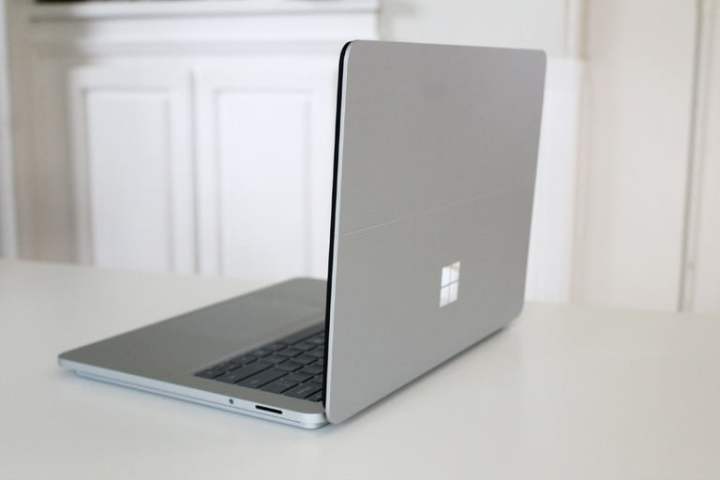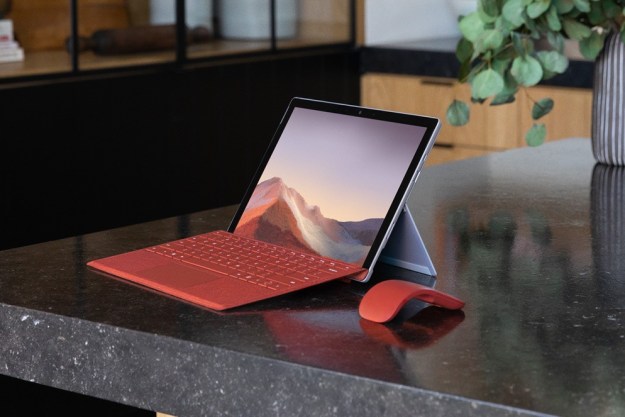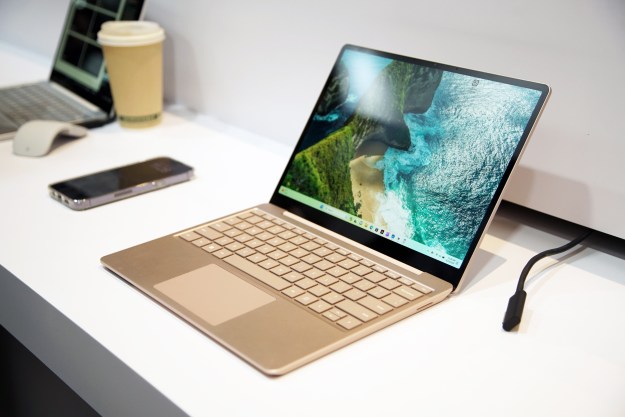Microsoft’s Surface Laptop Studio is a new product in the Surface lineup, offering the form factor of the Surface Laptop 4, along with some design inspirations from the full-size Surface Studio. It’s also more expensive than the Surface Laptop 4, though with specs to justify the extra cost.
There’s a decent gap between these two machines, both in price and specs. On their face, however, they look similar. We’ve reviewed both, so we’re here to break down all the differences between the Surface Laptop Studio and Surface Laptop 4 so you know which one to pick up.
Price

The Surface Laptop 4 starts at $1,000 for the 13-inch model with an AMD Ryzen processor. If you want the 15-inch version, which is available with an Intel Core i7 or AMD Ryzen 7, the starting price jumps to $1,300. At the top end, you could spend as much as $2,400 on the Surface Laptop 4 with 32GB of RAM and a 1TB SSD.
The new Surface Laptop Studio starts at $1,600. Microsoft hasn’t announced pricing for the top-end version. The base model comes with a Core i5 processor, 8GB of RAM, and 256GB SSD. If you want the dedicated RTX 3050 Ti graphics card or a Core i7 processor, you’ll have to pay $2,099 for the extra power — a full $500 more.
The difference is pricing makes sense given the disparity in power. Both machines use Intel’s 11th-gen mobile processors, but the Surface Laptop Studio uses the more powerful H35 chips, which can run at up to 35 watts. It also comes with an option for a dedicated graphics card, which the Surface Laptop 4 lacks.
Design

The difference in design between the Surface Laptop 4 and Surface Laptop Studio both are traditional laptops, so they don’t have detachable keyboards like the Surface Pro 8. The Studio model borrows from Microsoft’s all-in-one Surface Studio and features a hinge on the screen that allows you to swivel it down. It also has a base on the bottomthat helps with airflow, one of the highlights we pointed out in our full review.
The swivel screen works in three modes. The first is like a traditional laptop with the screen pushed back. From there, you can pull out the bottom of the screen to cover the keyboard, which Microsoft calls “Stage Mode,” or you can lay it flat on the key bed for “Studio Mode.” We really appreciated these different modes of use when we reviewed the Surface Laptop Studio, finding that it was a fun design.
Although a big difference, the screen isn’t all that separates these two machines. Microsoft offers the Surface Laptop 4 in either a 13.5-inch or 15-inch configuration. The Surface Laptop Studio splits the difference with a single 14.4-inch model. Although larger, the Surface Laptop Studio isn’t much bigger than the 13.5-inch Surface Laptop 4, as it’s only 0.13 inches thicker, and 4 pounds in weight, close to the XPS 15 and Macbook Pro 16-inch in our tests.
Port selection is better on the Surface Laptop Studio, even if both machines are light on ports. It features two USB 4.0 ports capable of Thunderbolt 4, as well as a 3.5mm headphone jack. The Surface Laptop 4 comes with two USB ports as well, split across a USB-A and a USB-C connection supporting USB 3.2.
In our review of the Laptop Studio, we noted that we wished it has more ports. Not requiring an adapter would have been good, so if you need more ports, the Laptop 4 is better.
In terms of looks, the slightly older Surface Laptop 4 actually wins. In addition to four color options, Microsoft offers the Surface Laptop 4 with either a metal or woven alcantara tray. The Surface Laptop Studio looks to adopt a more straightforward design with silver aluminum around all points on the body.
We don’t know yet if it will be available in other colors, but we did like the rounded looks on the Surface Laptop Studio, finding that it helps set it apart from the competition.
The Surface Laptop Studio wins the design section, however, simply on the strength of its swiveling screen. It also comes with built-in charging for the new Surface Slim Pen 2, which is something the Surface Laptop 4 lacks.
Display

Despite a difference in size, the Surface Laptop 4 and Surface Laptop Studio have similar screens with a few key differences. They both use a 3:2 aspect ratio and have a pixel density of 201 pixels per-inch (PPI). The resolution doesn’t really matter — each of the screens hit the density at their given size — but they all fall around the 2,560 x 1,440 mark.
There’s one big difference between the two displays, however. The Surface Laptop Studio comes with a 120Hz refresh rate, while the Surface Laptop 4 is limited to 60Hz. In addition, the Surface Laptop Studio’s display supports Dolby Vision and comes with the aforementioned swivel hinge. Both screens support the Surface Pen, however, with 10-point multitouch.
Note that the Surface Laptop Studio also has exclusive support for haptics with the Surface Slim Pen 2. You don’t get this on the Surface Laptop 4. It’s another key difference, and something we really enjoyed, noting that it’s “a miracle” thanks to subtle haptics in the stylus. This display is good for creatives who want that pinpoint accuracy and pen-to-paper feel.
There really isn’t a contest here. With the same pixel density and features, the Surface Laptop Studio’s screen shoots ahead with its high refresh rate and Dolby Vision support. On the specs front, it’s a clear winner. We loved the 120Hz refresh rate and the fantastic image quality on the Laptop Studio, as well as the maximum brightness of 443 nits. Even the hinge durability was a highlight for us.
It’s important to note that 14-inch laptops are becoming increasingly popular — just look at the Razer Blade 14 — offering a balance between screen size, portability, and image quality. It comes down to preference, but if you like a 15-inch display without the bulk, the Surface Laptop Studio looks like a solid machine for creatives thanks to its vivid color profile and screen.
Performance

At its higher price, it shouldn’t come as a surprise that the Surface Laptop Studio packs more powerful hardware than the Surface Laptop 4. It comes with Intel’s 11th-gen H35 chips, paired with either an RTX 3050 Ti discrete graphics card or integrated graphics, as well as up to 32GB of RAM.
The Surface Laptop 4 uses the standard range of 11th-gen processors that aren’t as power-hungry. The bump in wattage makes a big difference. Although both machines sport quad-core processors, the H35 chip can run multi-core tasks as much as 33% faster (at least based on the one in the Acer Predator Triton 300 SE).
You’re getting a powerful Intel chip either way — the 11th-gen chip in the Dell XPS 13 shows that. However, the H35 chip is designed to deliver better performance in apps that stress the processor, namely creative apps.
There’s a wrench in these cogs, though. Microsoft offers the Surface Laptop 4 with AMD Ryzen 4000 processors as well, while the Surface Laptop Studio is limited to Intel. The 15-inch model of the Laptop 4 squeezes in an eight-core Ryzen 7 processor, and those extra cores make a big difference based on our testing.
The main problem is the context for the Ryzen chips. The Surface Laptop 4 doesn’t offer a discrete graphics option. That makes it a tough sell for creative apps like Adobe Premiere, which would otherwise benefit from the extra cores offered by the Surface Laptop 4.
Although the Surface Laptop 4 offers a more powerful processor, it throws all of the performance eggs into a single basket. The discrete graphics option on the Surface Laptop Studio rounds out the specs, making it more suitable for creative apps, as well as gaming.
In our real-world tests, we found that the Surface Laptop Studio can balance the power between the Intel CPU and Nvidia GPU. Though one of our low points was the CPU holding back the performance a bit (when compared to other machines), the Laptop Studio still did well. With a 5131 multi-core score, it didn’t do as well as an XPS (close to the 10,000 range), but in the PugetBench Premiere Pro benchmark, the GPU accelerated.
With the Surface Laptop Studio, things are more of a balancing act, but if you’re hoping to edit videos, or even do gaming, then there’s no reason why you should not buy the Laptop Studio over the Laptop 4. The dedicated GPU makes a difference, pushing demanding games like Civilization Vi close to 105 frames per second. You can’t even get to those levels on the Laptop 4, but just keep in mind that we did feel as though the Laptop Studio is more “middle of the road,” in performance — there are other laptops out there with a dedicated GPU that are better for the price.
Portability

With three screen sizes spanning our two competitors, it’s tough to make direct portability comparisons. Naturally, the 13.5-inch Surface Laptop 4 is the smallest and lightest of the of the three models. Beyond that, however, things get interesting.
The 15-inch Surface Laptop 4 is lighter than the Surface Laptop Studio. With the Core i5, the Surface Laptop Studio weights 3.83 pounds, while the 15-inch Surface Laptop 4 weights 3.4 pounds. If you want the i7 on the Surface Laptop Studio, you’ll need to deal with a weight of four pounds.
The Surface Laptop 4 is lighter no matter how you configure things. Sometimes that disparity is less than half a pound, but it could be more than a pound.
Although heavier, the Surface Laptop Studio isn’t much larger than the Surface Laptop 4. The 13.5-inch Surface Laptop 4 measures 12.1 inches wide, 8.8 inches long, and 0.57 inches thick. The Surface Laptop Studio is only slightly larger at 12.7 inches wide, 9 inches wide, and 0.7 inches thick.
The more interesting comparison is how much smaller the Surface Laptop Studio is compared to the 15-inch Surface Laptop 4. It trims 0.7 inches on the width and 0.6 inches on the length (though it’s still slightly thicker).
Battery life is better on the Surface Laptop Studio, too. Microsoft claims up to 19 hours under a typical use case with the Core i5 processor, compared to 17 hours on the Surface Laptop 4. AMD’s chips are more efficient, however, offering up to 19 hours of life on the 13.5-inch Surface Laptop 4.
If portability is your main concern, the 13.5-inch Surface Laptop 4 is the smallest and lightest option out of the lot. The Surface Laptop Studio isn’t much bigger, however, and it comes with longer battery life. Just be prepared to deal with a little extra weight.
Surface Laptop Studio wins
Though it comes at a heftier price, the Surface Laptop Studio bests the Surface Laptop 4 for us. Thanks to the new 120Hz screen and the optional dedicated GPU, the Studio is worth buying over the Surface Laptop 4. Just keep in mind that there are better gaming laptops out there for the same price, like the XPS 15, as an example.
Editors' Recommendations
- Best HP laptop deals: Get a 17-inch workhorse for $270 and more
- How to clean a laptop keyboard without damaging the keys
- HP Envy deals: HP’s most popular laptop starts at $630
- The best laptops under $1,000, tested and selected by experts
- The best budget laptops for 2023




